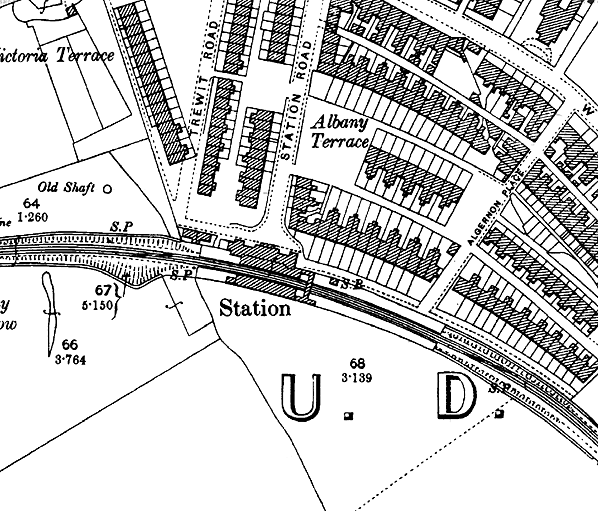Note: This two-platform station, designed by William Bell, bore a strong resemblance to its neighbour Cullercoats (opened the same day, and still open on the Metro). Both platforms were equipped with ridge-and-furrow glazed awnings, salvaged from the Blyth & Tyne Tynemouth station (closed on 3.7.1882). With the growing popularity of Whitley Bay as a holiday resort and residential area the NER replaced the 1882 station with a much grander edifice on a new alignment. As the new station took shape the old one was progressively dismantled, disappearing under the lavish new structure that was completed in 1912.
This station was renamed Whitley Bay (1st site) on 1.7.1899 and replaced with the present Metro station, Whitley Bay (2nd site) on closure. Whitley Bay (2nd site) survives on the Metro, a well-maintained and impressive facility, retaining its lofty clock tower, but the glazed platform roofing has been reduced in length.
BRIEF HISTORY OF BLYTH & TYNE RAILWAY (Hartley-Monkseaton ‘Avenue Branch’; Monkseaton / Whitley Bay / Tynemouth area)
1.gif) |
The southern end of the Blyth & Tyne Railway has a complicated history. Until 1861 there was a single route south from Blyth and Seghill through Prospect Hill to Percy Main, with a terminus adjacent to the NER station. However that year a new branch was opened, following the route of the former Whitley Waggonway, extending from Hartley to Tynemouth. It |
should be noted that this included the stretch to what is now Monkseaton, which was to be known as the ‘Avenue Branch’, and that the line beyond to Tynemouth was half a mile inland of the present day Monkseaton – Tynemouth Metro line.
At the Tynemouth end the original terminus was quickly replaced with a new one on a short branch which curved south-eastwards, and that in turn closed when its branch was extended to a third terminus, which adjoined the 1847 Tynemouth terminus of what had been the Newcastle & North Shields Railway. These developments are shown on the series of accompanying maps.
| In 1864 the Blyth & Tyne reached Newcastle, with its terminus at New Bridge Street. This was achieved by diverting trains onto a new line just south of Holywell, through Backworth, Benton, and Jesmond. From Backworth a new line was opened to join the 1861 Whitley (Monkseaton) to Tynemouth route. Trains could now travel on the B&T from Newcastle (New |
2.gif) |
Bridge Street) to Tynemouth, making the Holywell – Prospect Hill – Percy Main route, and the Avenue Branch between Hartley and Whitley (Monkseaton) redundant. These two lines closed in June 1864 on the day when the Newcastle – Tynemouth service was inaugurated. In June 1904 the Avenue Branch reopened to passenger traffic.
 |
In 1874 the B&T was absorbed by the NER, and the opportunity was taken to reorganise the railway routes in the Monkseaton / Whitley / Tynemouth area. With the growth of housing and holidaymaking on the coast the ‘inland’ route from Monkseaton to North Shields was superseded in 1882 by one within sight of the sea, and the two formerly competing termini at Tynemouth |
were replaced with a splendid new through station. This created the coastal section of the familiar Coast Circle and Metro route, although there were to be realignments at Whitley Bay in 1910 and Monkseaton in 1915 where new, larger stations were built.
Click here for a list of sources and a Blyth & Tyne bibliography
Tickets from Michael Stewart & JC Dean. 1887 Bradshaw from Chris Totty. Route map drawn by Alan Young.
To see other stations on the Blyth & Tyne Railway Avenue branch click on the station name: The Avenue, Dairy House, Monkseaton (1st site), Whitley, Cullercoats (1st site), Tynemouth (1st site), North Shields (B & T) & Tynemouth (3rd site)
See also Seaton Sluice and the unopened Collywell Bay branch: Brierdene & Collywell Bay
See also
West Monkseaton, Monkseaton (2nd site), Whitley Bay (2nd site), Cullercoats (2nd site) & Tynemouth (4th site)
See also
Tynemouth (Newcastle & Berwick terminus) |

bay_first_old1.jpg)

1.gif)

2.gif)
.gif)

bay_first_old2.jpg)
bay_first1.jpg) The third Whitley station site was renamed Whitley Bay (1st) in 1899. The station stood on the site now occupied by the main building of its successor, the present Whitley Bay, which can be seen here; its site possibly extended a short way into the forecourt. This view is looking east.
The third Whitley station site was renamed Whitley Bay (1st) in 1899. The station stood on the site now occupied by the main building of its successor, the present Whitley Bay, which can be seen here; its site possibly extended a short way into the forecourt. This view is looking east.first2.jpg)

 Home Page
Home Page